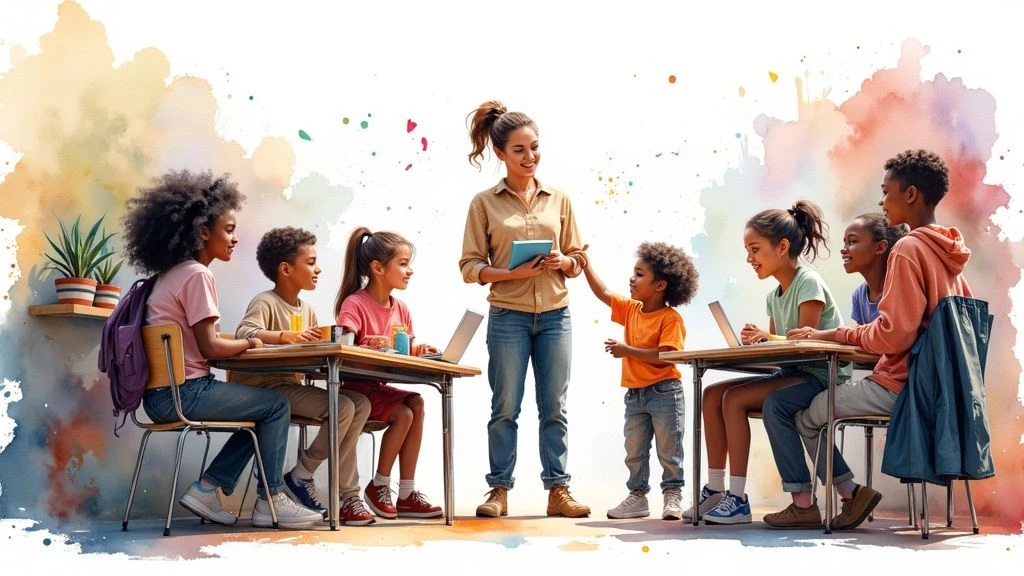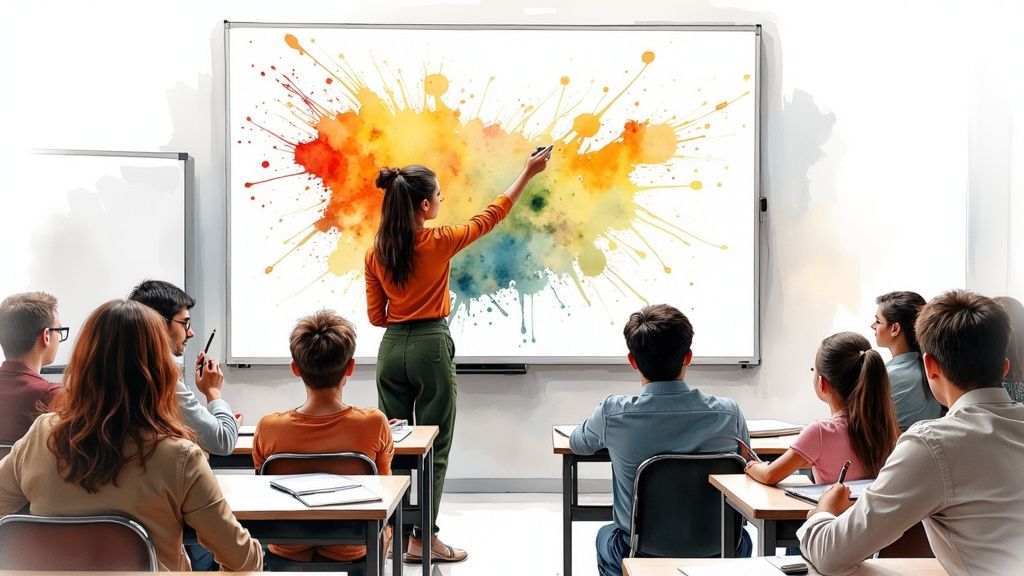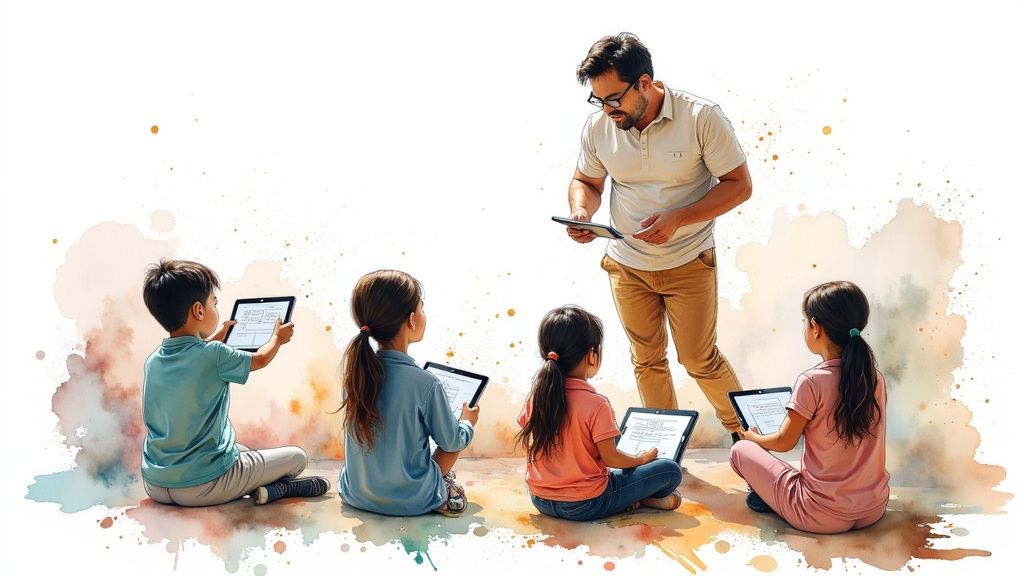10 Proven Classroom Engagement Strategies That Transform Student Learning
February 11, 2025

Understanding Today's Student Engagement Challenge

Teachers face a real and pressing challenge - students are becoming less engaged in their learning. This goes far beyond just having a quiet, well-behaved classroom. True engagement means students develop genuine enthusiasm for learning that fuels their academic growth. But what exactly does this look like in today's classrooms?
The Growing Disengagement Gap
The old standbys of long lectures and memorization just aren't connecting with students anymore. Young people need more hands-on, personalized ways to learn. The numbers tell a concerning story - student engagement dropped from 65% in 2018 to just 45.7% in 2021. Many teachers point to students' lack of internal motivation as the key factor. You can see more eye-opening statistics at STEM Sports' Student Engagement Report.
The Impact of Engaged Learning
When students are truly engaged, amazing things happen. They tend to get better grades, remember more of what they learn, and develop skills that last. Getting students engaged isn't just about making classes more fun - it's about giving them the tools and drive to succeed. Best of all, engaged students often become lifelong learners who stay curious and eager to discover new things long after they leave school.
Addressing the Root Causes
To boost engagement, we need to understand why students disconnect in the first place. Sometimes the material doesn't feel relevant to their lives. Other times, they don't feel like they belong in the learning environment. By figuring out these core issues, teachers can create strategies that work for each student's needs. This understanding helps build classrooms where every student feels important, noticed, and excited to learn.
Transforming Learning Through Interactive Engagement

When students actively participate in their learning, something amazing happens. The energy in the classroom shifts from passive listening to active discovery. Let's explore practical ways to make learning more engaging and see how these methods help students learn better.
Hands-On Activities That Spark Curiosity
Kids learn best when they can touch, build, and experiment. Think of a science class building simple machines to grasp physics concepts, or history students creating an interactive timeline on the classroom wall. These hands-on activities help students understand abstract ideas by making them real and tangible. Want to enhance visual learning? Check out these proven visual learning strategies.
The Power of Meaningful Group Discussions
Great classroom discussions do more than just fill time - they spark new ideas and deeper understanding. When students share thoughts and challenge each other's views, the classroom comes alive with learning. For example, literature students might unpack character motivations together, while social studies classes explore different perspectives on current events. These group discussions help students think critically and express their ideas clearly.
Experiential Learning: Making it Stick
Nothing beats learning by doing. Experiential learning could mean studying plants in the school garden, running a class business project, or exploring local history through field trips. Recent research from Engageli shows impressive results: students in active learning environments spoke up 13 times more often and scored 54% higher on tests compared to traditional lectures. These real-world experiences create lasting memories that connect classroom concepts to everyday life.
Addressing Diverse Learning Styles
Every student learns differently, and good teaching reflects this reality. Some students need to see it (visual learners), others need to hear it (auditory learners), and many need to do it (kinesthetic learners). Simple tools like custom coloring pages can help visual learners grasp history or science concepts. Audio materials support those who learn best by listening, while hands-on projects engage students who learn through movement and touch. When teachers mix up their methods, every student gets a chance to shine.
Using Technology to Build Stronger Student Connections

Smart use of classroom tech tools can make learning more engaging and meaningful. The key is finding the right balance - using technology to enhance great teaching rather than replace it. When teachers thoughtfully select and implement digital tools, they can create learning experiences that truly connect with students.
Making Technology Work for Learning
The best tech tools directly support specific learning goals. For instance, many teachers use interactive whiteboards to turn lessons into group brainstorming sessions. Learning apps provide instant feedback as students practice new skills at their own speed. By focusing on clear educational objectives, teachers ensure technology genuinely helps students learn better.
Combining Classic and Modern Methods
Great teaching often mixes proven methods with carefully chosen tech tools. A history teacher might pair an engaging classroom discussion with students collaboratively building an online timeline. In science, hands-on lab work can complement digital simulations that show microscopic processes. This approach captures the benefits of both personal interaction and digital resources.
Picking Tools That Get Results
With so many educational technology options available, knowing what works matters. A major study by Kami surveyed over 3,000 K-12 teachers about student engagement. They found that 53% of classrooms achieve high or very high engagement levels when using interactive activities, integrated technology, and group work. These findings help teachers choose tools that truly boost student participation and learning.
Real Examples of Effective Tech Use
- Science simulations: Students can explore physics concepts or chemical reactions through interactive digital models
- Group writing projects: Tools like Google Docs let students collaborate on assignments in real-time
- Adaptive learning software: Programs that adjust to each student's level and provide targeted practice
- Creative tools: Digital platforms like ColorPageAI help students express ideas visually. For example, students can create custom coloring pages of cell structures for biology or historical scenes for social studies.
When teachers carefully choose and implement technology, they create classrooms where students actively participate rather than passively receive information. This leads to deeper understanding and more meaningful learning experiences for everyone involved.
Making Data-Driven Decisions That Impact Learning

Good classroom engagement isn't just about fun activities - it's about understanding what actually helps your students learn best. When teachers collect and analyze data about their students' learning, they can make better decisions about how to teach effectively.
Identifying Struggling Students Early
Teachers can use Student Information Systems (SIS) to spot which students need extra help before small issues become big problems. Looking at grades, attendance records, and participation metrics helps paint a clear picture of how each student is doing. For example, dropping grades or increased absences often signal that a student is struggling and needs support. Learn more about tracking student engagement at Myaequitas.
Targeting Interventions Effectively
Every student learns differently, so a one-size-fits-all approach rarely works well. By looking at data for individual students, teachers can provide the exact kind of help each one needs - whether that's extra practice time, working with a study buddy, or getting additional learning materials.
Measuring What Matters: Impact on Learning
Data helps show which teaching methods are most effective. When teachers track how different activities affect student participation and test scores, they can focus on what works best. This practical approach lets them keep improving their teaching methods based on real results.
User-Friendly Tools and Tracking Methods
Collecting useful data doesn't have to be complicated. Many simple tools can help track student progress without creating extra work. For example:
- Online learning platforms that automatically record quiz scores
- Simple checklists for tracking participation
- Quick surveys about specific lessons
- Notes about student questions during discussions
The key is picking tools that fit naturally into your teaching style and classroom routine. When used thoughtfully, data becomes a helpful guide for creating a classroom where every student can succeed.
Building Powerful Collaborative Learning Communities
Students learn better together. When kids work in groups, they develop social abilities alongside academic knowledge by practicing communication, finding compromise, and contributing to shared goals. Let's explore proven ways to create group learning that engages students.
Designing Effective Group Activities
The key to great group work is smart planning. Each activity should get students talking and working together, like having defined roles (note-taker, researcher, presenter) so everyone participates. The sweet spot is making tasks complex enough to need teamwork but achievable enough to avoid frustration. This keeps students focused and cooperative. You might be interested in: Creative Expression Activities.
Structuring Groups for Success
Group makeup matters a lot. Mixing students with different academic levels creates natural peer teaching - strong students help others while reinforcing their own learning. But don't forget personalities. Sometimes letting students have some say in their groups boosts their interest and involvement.
Managing Group Dynamics and Participation
Even well-planned group work needs guidance. Set clear rules for communication and handling disagreements before starting. Simple steps like establishing respectful discussion guidelines prevent many issues. Teachers should move between groups, ask good questions, and check that every student gets heard and valued.
Adapting Collaboration Across Subjects and Grades
Group work fits any subject. Younger students do well with hands-on projects like building models or writing stories together. Older students can tackle bigger challenges - think joint research projects or team presentations. The key is matching the task to student abilities.
Measuring Group Success and Providing Feedback
Good feedback makes group work better. Look at both the final product and how well students worked together. Using scoring guides that cover academic goals and teamwork skills gives a complete picture. Have groups reflect on what went well and what needs work - this builds awareness and helps them improve next time.
Sustaining Engagement Success Throughout the Year
Building and maintaining student engagement is an ongoing journey that requires consistent attention and care. Let's explore proven ways to keep students actively participating and excited about learning all year long, regardless of their background or the subject being taught.
Adapting Strategies Throughout the Academic Year
Students' needs evolve as the school year progresses, requiring teachers to stay nimble with their approach. What works brilliantly in September may need adjustments by March. For example, you might switch from solo assignments to group projects, bring current events into lessons, or try new educational tools to keep things fresh. The secret is staying responsive to your classroom's changing dynamics.
Combating Burnout and Maintaining Interest
Academic burnout can affect students as the year progresses. Smart prevention includes building in regular breaks, adding calming activities, and giving students choices in their assignments. Regular one-on-one check-ins help spot early signs of fatigue, allowing you to make timely adjustments. Read also: Powerful Group Art Therapy Ideas.
Addressing Varying Skill Levels
Supporting diverse learners means offering different levels of challenge within the same activity. A math lesson might include basic, intermediate, and advanced problem sets, while reading assignments could span various complexity levels. This approach helps each student feel challenged yet capable of success.
Practical Solutions for Changing Classroom Dynamics
Classes rarely stay static - new students arrive, schedules shift, and group dynamics evolve. Having ready-to-use engagement strategies helps manage these changes smoothly. Consider:
- Team activities that build classroom community
- Flexible seating options for different learning styles
- Regular student feedback sessions to address new needs
Real-World Examples of Sustainable Engagement
-
Learning Stations: Create activity centers around your classroom where students rotate through different tasks. This works well for any subject area.
-
Student Choice: Let students pick their projects or learning methods to boost their motivation and sense of ownership.
-
Feedback Loops: Make time for students to share thoughts about their learning experience and reflect on their growth.
ColorPageAI offers a creative way to maintain engagement throughout the year. Use it to generate custom coloring pages that connect to your current lessons, whether they're about historical figures, scientific concepts, or literary themes. These visual activities help students grasp abstract ideas while adding an element of fun to their learning process.
Ready to start coloring?
Join ColorPage.ai today and get 5 free credits to create your own custom coloring pages!
Start creating